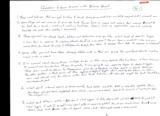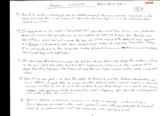|
Basic Assignments
|
Options & Settings
|
Main Time Information
|
||||||||||||||||||||||
|
|
|
|
|
||||||
|
||||||
|
|
|
Notes:
|
|
Questions & Known Issues with Balance Sheet 1. Things must balance. That can get tricky and hard. Every penny needs to be counted and assigned to the correct can. 2. Some things are real monies and some are book figures (not an actual cash values). Real monies need to be tied to a bank, investment, cash on hand, etc. Items such as depreciation may not actually translate into cash. This creates a disconnect. 3. Things (monies) can change hands, status, and destinations very quickly. What kinds of events trigger a move from an expense to a balance sheet item? Or vice versa? Say you have a customer who owes you money (A/R). You decide to write it off (clear the books). How does it change from A/R to expense or whatever? 4. Quite often you will have items changing status within their own group. Say cash (bank A/R) to inventory which is also an asset. 5. I’m worries about showing things multiple times on the same report. This has been a fear because I wasn’t sure how to show things. Originally, I was going to use expense types and deposit types. Those items would be shown by themselves plus be reflected in the cash or bank balance. The other problem is that some of the expense and deposit types don’t need to be shown on their own and should only be shown in the final bank balance. An example might be bank transfers or reimbursements paid. 6. What about internal repairs (internal invoices), bad debt, credits, NSF on checks, update P.O.’s, shrinkage, pre-paid items, capitalized items, refunds, monies over and short, due bills, breach of contract? And the list goes on…. 7. What about selling or renting a B.S. item? What happens if fully depreciated and still sold for profit? What happens if sold for a lost (loss)? What about gifts or receiving gifts? How do you record values if real money doesn’t change hands. Random note – all deposits require a bank – that might create a disconnect. 8. How do we automate payments (coming in and going out)? Is this required on the first round or sometime later? Along the same lines – what happens if we are ahead or behind the pay cycle (pre-paid or under paid)? 9. I need to set up a number of watchers or flaggers that can work over time. How do I do that so they can keep running totals and also be able to drill-down to details (in the past). I don’t see a problem if running on current data. What happens if the user wants a snap shot of days and time past? Random thought – if you use a snapshot analogy – a true snap shot is taken at the current time and then you look at it later on. In the digital world – I imagine that a user would like to virtually go back in time and see the snap shot of how it was even though things have changed and continued. This is where it gets tricky. 10. Classic model vs. new adilas model – The classic model is Assets, Liabilities, and Equity. The new model would be similar but show real , where am I values, with how much is owned, how much is still owed, and current value. An example might be: classic model – an asset (van) for $10,000 and long term A/P (loan) for $10,000. I would like to show it as an asset (van) valued at $10,000, paid $6,000, owe $4,000 and long term A/P (loan) value of $10,000, paid %6,000, and only owe $4,000. Paper doesn’t do it justice. Basically, I want to include real-time values to give a cleaner look at where we are. 11. How are we going to handle starting values? Say you know that at the end of last year you owed xyz. How do you keep things straight without having all of the details (or do we need all of the details)? This could get tough if we start signing up existing businesses that have years and years of history. Another thing to consider is the starting bank balance and the starting bank date. These are already included on the add/edit bank pages. 12. How do I maintain a duality (at least two offsetting accounts)? Not every transaction is processed in the exact same way. Plus, it may require a transfer within the same type or a 1-many relationship that could be any number. 13. I’m hoping to use an item called a “balance sheet item”. Each item would have its own name, destination, starting value, running value, sort, etc. We can tie in photos, sub, tables, etc. to each item. Basically, each item will be a special “can” with a name. The basic info will be ongoing and the details of what happened to it (baggage) will be carried by each item. We will record history info and possibly “snap shot” history. I’m not exactly sure on the snap shot history (what that means or how we will do that) but it might help with look backs. 14. The above item (B.S. Items) are a great idea but how do you deal with things the system is doing on its own (short term A/R’s, short term A/P’s, bank balances, inventory counts, P&L net profit, etc.). Maybe these things keep going in the background until the user “takes a picture” and thus create a snap shot history. 15. One of my main goals is to have the system be functioning and the balance sheet show up as an “effect” of good data. A number of other software systems require a post or physically recording where things are at. I want the numbers to just flow through as a result of normal usage. Let operations dictate to accounting what is happening. This takes the word “adjustment” out of the picture. It is what it is… 16. Speed vs. flexibility vs. server load vs. dynamic vs. static vs. frequency – This will be a full on balancing act. What is the most important? What is the easiest/hardest to maintain? What do our customer and users want? How easy/complex is this report going to be? 17. Because we are not doing traditional double entry accounting, how do we incorporate cross checking and dynamic multi checking? Instead of 1 to 1 (standard double entry) – what about multi-cross checking. How do we empower the users (corps) to set up their own cross checks that the system can monitor? If we can figure this out, it would help the users know where the problems are. This would be worth tons and would end up saving tons of time looking for the problems. 18. The good thing about B.S. Items is they are changed less frequently than normal day-to-day items. Maybe weekly, monthly, quarterly, or annually. Usually not daily. This is the outer loop (inter loop being daily business transactions) 19. What happens if the balance sheet won’t balance? Do we provide a force balance or do we require the users to check the cross checks and really make the data correct? It would be so cool if there was no way to trick it. That will be tough. 20. What prep steps do we need do? Maybe create watchers, flaggers, history points, etc. What about parts and running off or part-id instead of vendor and part number? 21. Maybe we need to have the B.S. report be dynamic. This means we only show things that are active and have a value. Maybe we allow the users to rename a system generated category (default to what we think but give them some flexibility on what to call it). Maybe we only provide drill-downs on current date. B.S. reports. Archived “snap shots” won’t have drill-downs, just numbers and text values. Current is crunch on the fly and archived is just a saved report. 22. Maybe we allow users to look up small sections of the balance sheet (in the current time or in the past) but we limit it to just a certain section at a time. This would lessen the server load and allow for special code and lops or smaller groups of data. These more detailed looks would crash the server if done as a whole. |




